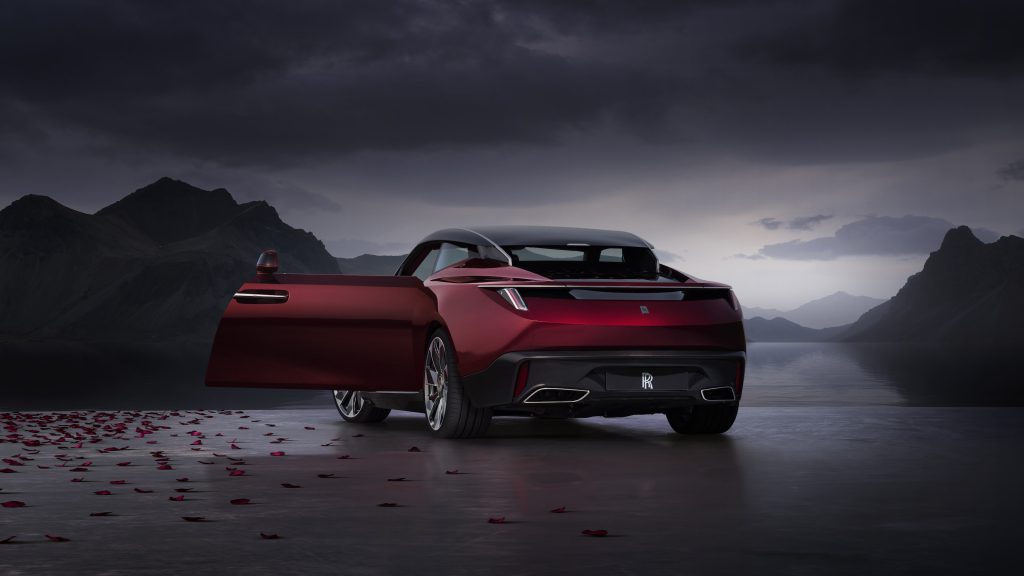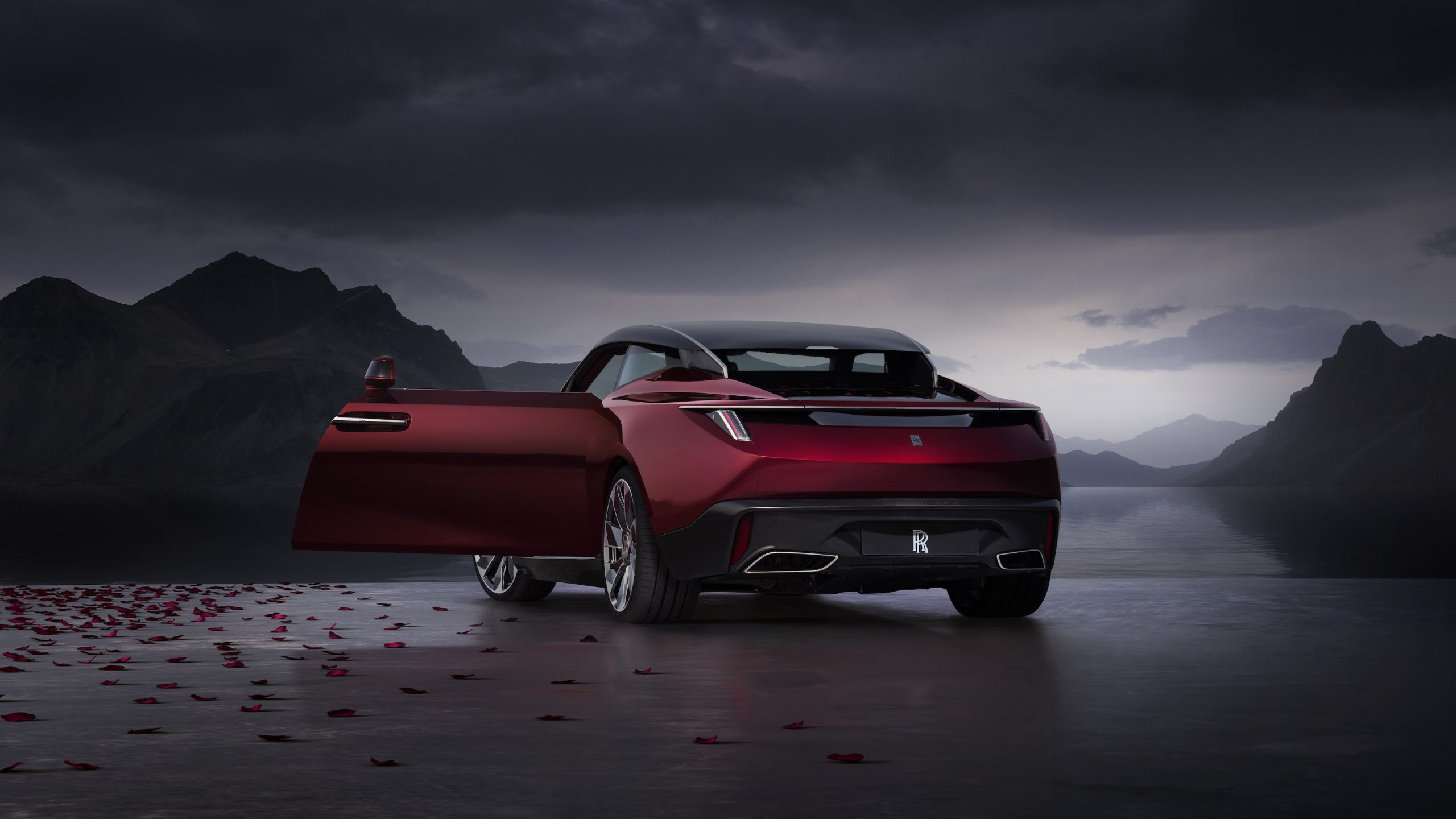[ad_1]
Dubbed La Rose Noire, the form is reminiscent of a vintage muscle car while the colors and materials are inspired by the French Black Baccara rose

La Rose Noire Droptail is the latest Rolls-Royce coachbuild car and the first in the series of four unique vehicles, which debuted publicly this past weekend at Monterey Car Week. We had the opportunity to see the car at Rolls’ headquarters in Goodwood last month and spend time with Anders Warming, the Director of Design, and Alex Innes, Head of Coachbuild Design, to learn more about the coachbuild process and see La Rose Noire in the very restricted-access studio where it was hand built.

Introducing the vision for Droptail, Warming says, “In the dialogue with clients we realized there’s another [coachbuild] story to be told. And that’s why we called it The Tale of Tails. We had Sweptail. You also know… that Boat Tail is an important building block. We knew that there was another story that needed to be told. And when a client approached us with a similar idea we said there is a car that hasn’t been done before.” Sharing a photo of a 1931 Rolls-Royce Phantom II Henley Roadster by Brewster, he notes, “It’s a very romantic approach—two people, just two, driving in a car… collar up, driving down the road… Just the two of us driving in this car hand in hand is the story of Droptail.”

Twenty years ago BMW acquired the Rolls-Royce name for automobiles and the Spirit of Ecstasy, its well known emblem. Since then Rolls-Royce has been on a journey to recapture the innovation, engineering and excellence the brand was known for. First came its series production cars—
Spectre (our test drive impressions coming soon), Cullinen, Ghost, Phantom, Dawn and Wraith—many of which featured very customized expressions as limited editions by the brand or single customer commissions. In 2017 the company’s Coachbuild department launched Sweptail, a unique vehicle designed for a single client. Boat Tail, a series of three unique vehicles, launched in 2021. Droptail is a series of four unique two passenger cars, and La Rose Noire may be the only one that will be shared publicly. Sweptail and the Boat Tail series, while completely custom, leveraged existing platform architecture. Droptail, however, is the first coachbuild vehicle to have its own unique platform architecture.
Only the house of Rolls-Royce can offer its coachbuild clients the opportunity of commissioning a product of future historical significance that is as fundamentally unique as its owner. This is contemporary patronage in its truest form.
Torsten Müller-Ötvös, CEO Rolls-Royce
Coachbuild at Rolls-Royce is like F1 to Ferrari, Mercedes, Aston-Martin, McLaren and Alfa Romeo—the halo and awareness those vehicles provide to their brands is immense, but it’s equally about the engineering and design innovation that eventually makes its way into their regular production vehicles—paid r+d essentially. Coachbuild projects provide a showpiece for the brand alongside innovation in design, materials and engineering that is leveraged into future production cars. Torsten Müller-Ötvös, who is on a first name basis with more customers than almost any other CEO, says, “We work in close harmony with our clients to understand the nuances of their character and personalities and to carefully translate these qualities into the elements with which they wish to imbue their commission. Only the house of Rolls-Royce can offer its coachbuild clients the opportunity of commissioning a product of future historical significance that is as fundamentally unique as its owner. This is contemporary patronage in its truest form.”
The coachbuild process goes something like this. You’ve demonstrated that you have both an affinity for the brand as well as a commitment to it, and you have the type of personality that is compatible with the three to four year process required to create your coachbuild. It’s as much about who the brand wants to create the experience with as it is a customer desiring to have the opportunity, and it’s as much about the journey as it is the end result. Warming notes that “this is a process where normally no client of any brand is invited. Here is an opportunity for a client literally to put on protective shoe covers and… start shaping his or her body panels and tell us ‘what I’m looking for is something like this’ and we of course know what we have to do to make it happen.” Key moments of your experience and your car’s development are captured along the way, resulting in a very thorough book chronicling the process that is delivered along with your vehicle.
Innes shared that the brand’s storied past alongside its “vigor and confidence… today” permit the company “to explore the future in a very bold and progressive way.” He noted that the large chassis used in the 1920s was mostly fitted with limousine bodies in Europe, but when they were sent to America they noticed that many people, inspired in part by F. Scott Fitzgerald’s Jay Gatsby character, sought the freedom of driving themselves instead of being driven, and began outfitting the large chassis not with sedans and limousines but coupes. “It’s that sense of fun, that sense of conviviality that really is for us the spirit of this car,” he states. Untypical for a Rolls-Royce, the Droptail has a very short front overhang, generous body side and a very shallow windscreen proportion. Occupants are nestled deep down inside the car. Also very untypical for Rolls-Royce you see a more compact rear overhang together with a very expressive treatment to the overall surfacing.

“I always joke that on day one as a designer, the first thing you’re told that at Rolls-Royce is don’t touch the grille and don’t touch the Spirit of Ecstasy. This particular project was liberated by the significance of producing the only modern roadster body style, and we felt there was the permission to also experiment with the treatment of these elements,” Innes says. Grille veins are bent and rake backward in their upper portion for the first time instead of being fully vertical, and are painted on one side to further their impact. Alongside its deep set headlamps it presents a balanced, focused, concentrated look. The low and tight seating area features a transom area that mimics a yacht’s design, which gets truncated across the rear, creating a very pure surface that’s atypical in the automotive space but adds a unique way of celebrating a drop tail. He adds, “Droptail is transformed from an open top roadster into a dramatic and formidable looking coupé” when its roof canopy is in place, creating a second personality and a “unique statement, very much motivated by the wishes of the clients.”


The Droptail’s form was inspired by west coast hot rods in the 1930s—not a typical reference inside the design studio. Innes chuckles as he shares, “We wanted to experiment here again, to pivot people’s understanding of what a modern Rolls-Royce can be.” As he walks us through all of these elements, each of which requires a painstaking amount of design, refinement, engineering and homologation, we start to understand why the process takes so long, how complex it is and how much it costs to achieve—and that’s just the car’s structural elements.

Moving to paint and the car’s multifaceted interior, another new world emerges. Though more familiar—we’re quite used to elaborate leatherwork, parquetry and even integration of custom clocks and timepieces—the interior’s shape pushed the limits of even Rolls-Royce’s craftspeople. It features three key gestures: the line that comes off the grille envelopes the occupants and circles back toward the front, the floating central armrest, and the simplicity and clarity of the cabinetry-inspired facia—you are not deciphering a large computer screen while piloting this car. Innes notes, “This is not a sports car per se, but it has to have that agility to it by way of how you sit and how the interior is appointed around you… This relationship between the precision of the eye and dexterity of the finger to create something extraordinary by way of its shape and this process—when you consider we are only producing these cars in highly limited numbers—to work on a clay model for over nine months seems almost ridiculous, but that level of precision and control to the surfaces is an incredibly important aspect of our development.”
The clients requested that the car celebrates their affinity for France, where they have multiple properties including “a sizable concern in Champagne.” The aforementioned Baccara rose features an iridescence and lack of uniformity to its color that become core to the car’s personality, from its paint to the surfaces’ texture, composition and way they look in different light. Its leather features that iridescence, with the parquetry an abstraction of rose petals and its multi-dimensional paint shifts between deep red and near black. “The client’s wish was to create the impression that rose petals have been thrown over the interior and exterior surfaces” in a very abstract way. This resulted in “the most complex parquetry in the history of Rolls-Royce,” shares Sina Eggl, the lead color and trim designer. “We put together some new techniques and understandings on how we could veneer across such complex geometry. The triangles have to be hand-sculpted and hand-shaped to match the geometry and fit perfectly within the pattern” when applied across the interior arches.

Blackwood is the main wood used, but the team sought out sheets with heavily varied figuring to avoid looking flat. This starts with the tree itself of course, but relies on the way you cut it into logs and then into the veneer sheets so they reflect the light differently depending on the amount of figure that appears within it. Triangles were cut from three intensities of coloration and “fig” and then applied in varied directions, providing a sense of different colors and shades simply through leveraging refraction. The base pattern is symmetrical but the petal pattern is asymmetrical, and each of the 1,603 triangles was hand-sanded, adjusted and placed to make it look and feel random. Red “petals” are the same veneer that’s been painted. All in, the parquetry alone took nearly nine months to create. Honoring the client’s request to speak to their connection to France, a local tree was found and used for these elements. Innes notes, “it’s not about over-personalization, it’s about these choice details in the story that they will tell that wear the personality of the client.” It’s all in the details.


Rolls-Royce doesn’t have a single watch partner, instead allowing customers with a level of access parallel to their relationship with the automaker to create an additional layer of exclusivity. This owner commissioned Audemars Piguet to create a unique La Rose Noire watch featuring a quick-release band. The timepiece can then be inserted into its dashboard home; its band goes into a custom case in the driver’s door. The engineering and homologation required for this feature alone is likely similar in cost to at least one of the brand’s production cars.
For those that have the vision and the extravagant opportunity to collaborate with the coachbuild design team it offers an incredibly rare and extremely personal vehicle that truly is one of a kind. Coachbuild customers “love that their car is important, that it has value in the world of car design,” Warming says. There’s no doubt that decades from now at shows like the Concours d’Elegance at Pebble Beach and the Concorso d’Eleganza Villa d’Este we’ll see these coachbuild vehicles by Rolls-Royce.
[ad_2]
Source link https://coolhunting.com/design/rolls-royce-debuts-the-first-droptail-coachbuild-comission/

Leave a Reply
You must be logged in to post a comment.